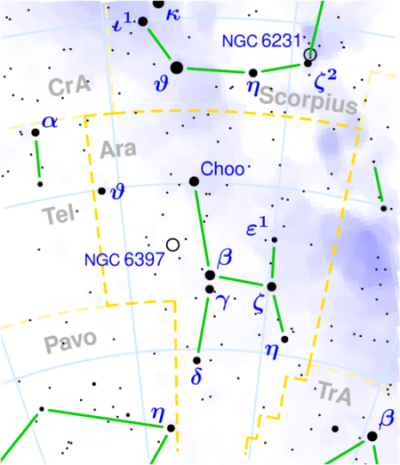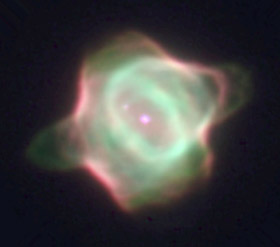Ara (constellation) (original) (raw)

Ara. © 2003 Torsten Bronger.
Ara (abbreviation: Ara), the Altar, is a small southern constellation that is rich in star clusters. See below for details of the constellation's brightest stars and interesting deep sky objects.
Stingray Nebula
 |
|---|
| The Stingray Nebula. Hubble Space Telescope image. |
The Stingray Nebula (Hen 3-1357) is the youngest known planetary nebula and,as a result, one of the smallest. Its diameter is only about one-tenth that of most objects of its kind. It lies at a distance of about 18,000 light-years.
| Stars in Ara brighter than magnitude 4.0 | ||||||
|---|---|---|---|---|---|---|
| star | vis mag | abs mag | spec type | distance (ly) | RA (h m s) | Dec (° ' ") |
| Beta | 2.84 | -3.50 | K3Ib-IIa | 603 | 17 25 18 | -55 31 47 |
| Alpha (Choo) | 2.84 | -1.52 | B2Vne | 242 | 17 31 50 | -49 52 34 |
| Zeta | 3.12 | -3.11 | K3III | 574 | 16 58 37 | -55 59 24 |
| Gamma | 3.31 | -4.40 | B1Ib | 1,140 | 17 25 24 | -56 22 39 |
| Delta | 3.60 | -0.20 | B8Vn | 187 | 17 31 06 | -60 41 01 |
| Theta | 3.65 | -3.81 | B2Ib | 1,010 | 18 06 38 | -50 05 30 |
| Eta | 3.77 | -1.14 | K5III | 313 | 16 49 47 | -59 02 29 |
| Other objects of interest | ||
|---|---|---|
| name | type of object | notes |
| NGC 6193 | open cluster | A good object for binoculars, containing about 30 stars. Magnitude 5.2; diameter 15'; RA 16h 38m, Dec -48° 40' |
| IC 4651 | open cluster | Richer but fainter than NGC 6193 and requires a small telescope. Magnitude 7.1; diameter 12'; distance 3,600 light-years; RA 17h 21m, Dec -49° 54' |
| NGC 6397 | globular cluster | The brightest of three easy globulars in Ara; it can be glimpsed with the naked eye and looks like a misty patch in small instruments. At a distance of about 8,200 light-years, it may be the second closest globular to Earth after M4. Magnitude 5.6; diameter 25.7'; RA 17h 37m, Dec -53° 39' |

